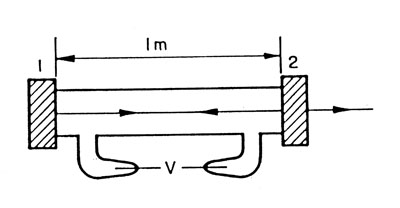In Figure 3.2, 1 and 2 are fully and partly silvered mirrors respectively which form a cavity.  is a high is a high  voltage used to excite the He atoms. Gas in the cavity is at a low pressure; the partial pressures of He and voltage used to excite the He atoms. Gas in the cavity is at a low pressure; the partial pressures of He and  are 1 and are 1 and  of mercury (1/300 and 1/3000 of the standard atmospheric pressure). The lasing action is related to stimulated emission of the Neon atoms. Helium atoms are excited to metastable states by the external applied voltage. These can return to the ground state only by collision with unexcited Neon atoms. In the process, the upper most energy levels of Neon get populated. As the Neon atoms in turn return to lower energy levels the photons released stimulate additional radiation from excited Neon atoms and the entire process is intensified by the reflecting cavity walls. The wavelength of of mercury (1/300 and 1/3000 of the standard atmospheric pressure). The lasing action is related to stimulated emission of the Neon atoms. Helium atoms are excited to metastable states by the external applied voltage. These can return to the ground state only by collision with unexcited Neon atoms. In the process, the upper most energy levels of Neon get populated. As the Neon atoms in turn return to lower energy levels the photons released stimulate additional radiation from excited Neon atoms and the entire process is intensified by the reflecting cavity walls. The wavelength of  (an orange-red-color) is chosen over other wavelengths by proper choice of the cavity length. The atomic processes taking place in the laser cavity is sketched in Figure 3.1. (an orange-red-color) is chosen over other wavelengths by proper choice of the cavity length. The atomic processes taking place in the laser cavity is sketched in Figure 3.1.

Figure 3.2: Construction of Helium-Neon Laser.
|